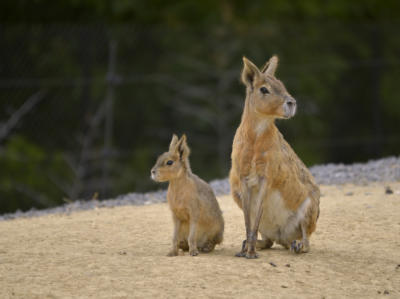New microbes discovered in a Patagonian mara, tobacco fields and hospitalized patients
Posted on May 14, 2019 by Laura Cox
Each month, the Microbiology Society publishes the International Journal of Systematic and Evolutionary Microbiology (IJSEM), which details newly discovered species of bacteria, fungi and protists. Here are some of the new species that have been discovered and the places they’ve been found.
Researchers in Brazil have discovered a new species of yeast in rotting wood, mushroom and tree bark collected from Brazilian ecosystems. The same group also found other strains of this new species in berry samples in French Guiana. The new yeast species was named Kutzmaniella hittingeri, and was named after the American scientist Chris Todd Hittinger.
‘Thermophiles’ are living organisms that thrive at higher temperatures, usually over 40°C. Two new species of thermophilic bacteria were discovered in Japan this month. These bright orange bacteria were isolated from clay soil collected in Onikobe, Japan, and were named Thermogemmatispora aurantia and Thermogemmatispora argillosa. Onikobe is one of the country’s most active geothermal areas, with several hot springs and geysers, and these bacteria grow best at 60–65°C.

Ephemeroptericola cinctiostellae, a new genus and new species bacteria was discovered by researchers from Korea. The bacterium was discovered in the gut of Cinciticostella lecanidovae, an aquatic insect that feeds on algae and organic matter.
Often plants and bacteria have mutually-beneficial symbiotic relationships. In some cases, a bacterium will provide protection against certain diseases in order to protect their host and obtain nutrients. In Israel, researchers have discovered a new species of bacteria which protects plants against pathogens which invade the phloem cells. The bacteria, which the researchers named Frateuria defendens, was isolated from the planthopper Hyalesthes obsoletus. This insect is usually a vector for yellows grapevine disease, so it is interesting that is also is a vector for microbes which can provide protection.
Due to their high concentration of sodium carbonate, soda lakes are some of the most productive aquatic environments on Earth. In a soda lake in north-eastern China, a new genus and species of bacteria named Alkalilacustris brevis has been discovered by researchers. This novel bacterium thrives in alkaline conditions and requires high concentrations of sodium to grow.
Two new species of bacteria have been found in the soil of a tobacco field in China. These new species were collected from the arable soil and the plant’s rhizosphere - a diverse microbial community that lives in the soil around plant roots. The bacteria were named Dyella tabacisoli and Lysobacter tabacisoli.

The Patagonian mara,
where Bifidobacterium dolchotidis
was discovered
Researchers from Italy and Ireland have discovered five new species of bacteria in the genus Bifidobacterium. The researchers were studying gut bacteria in over 290 different species of mammal and isolated these new bacterial species from faecal samples. They collected Bifidobacterium castoris from a European beaver, B. callimiconis and B. goeldii from Goeldi’s marmosets, B. samirii from a black-capped squirrel monkey and B. dolchotidis from a Patagonian mara.
A new, fluorescent species of bacteria has been isolated from two hospitalised patients in Japan and Myanmar. The bacteria were collected from the faeces of a man and a woman who suffering from diarrhoea in Japan. The same species was later found in another patient with a suspected urinary tract infection in Myanmar. The new species was named Pseudomonas asiatica.
The full papers describing these species are available to journal subscribers, but the abstracts are free to read. Articles can also be purchased individually with the pay-per-view option.

